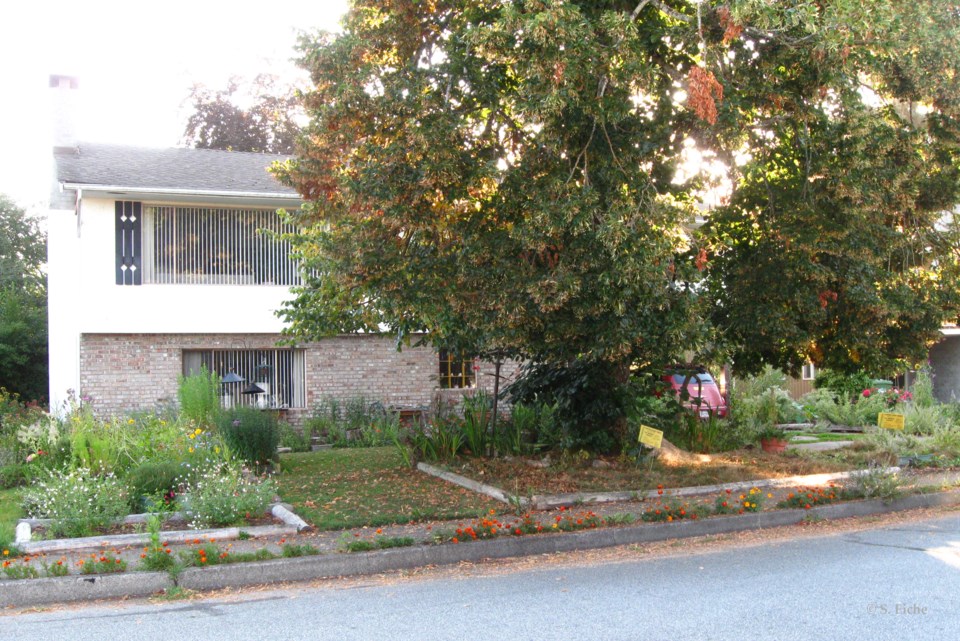I haven’t always been against lawns. In fact, when I was a little girl, I didn’t even know that private houses could have lawns. In my hometown in Germany, only the city park had lawns. They were surrounded by low fences and sprouted signs warning against walking on the grass. They were not inviting places. Private houses in town usually had gardens at the front and back. The house in which we lived had two very old linden trees at the front, flower and vegetable beds and berry bushes behind the house, and at the very back a meadow, open and inviting. Good things happened there, for pollinators and people. It was full of wildflowers. And it was where I took my first steps, at 10 months, a moment held fast in a photograph.
Our first home in Canada was a little bungalow in Burkeville. The backyard was almost completely taken over by an old apple tree and a plum tree. There was grass on the ground but it didn’t grow well under the trees. I don’t remember that it ever got mowed. Our front yard was carpeted with clover and buttercups. Such natural, no-fuss lawns provided food for pollinators.
After Burkeville, we moved to a bungalow on Leslie Road. It, too, had grass in front and back. The backyard, which was huge, also had three fruit trees and a vegetable garden along the west side. At that time in our neighbourhood, the grass growing in the yards was often mixed with clover, buttercups and other wild plants. The era of manicured lawns was still decades away. My father mowed our grass but I had to rake it. That was the moment the seeds of my dislike of lawns were sown. I loathed raking grass but never found a way to get out of it.
When we moved to our present house I was going to university and therefore conveniently absent whenever the lawn got mowed, and after graduation, I moved to Italy. Now that I’ve returned I’ve had to face the lawn.
I’m not sure when lawns became a kind of status symbol here in Richmond, but it may have been around the 1960s when many new subdivisions were being built. In the last 25 years or so houses constructed ex novo in Richmond have usually been mega-mansions. Their diminished back and front yards tend to be either paved over or decorated with a patch of manicured lawn, or a combination of the two. Landscaping at these mega-mansions is generally done without any consideration for pollinators or beneficial insects. The preference is for ornamental plants.
Fortunately, we’re gradually becoming aware of the problems we’ve caused ever since we started trying to take control of nature for our own ends. Suggestions for how to heal the harm caused by the mania for manicured lawns are snowballing in the media. It all began less than a decade ago with a call for people to stop mowing their lawns in the month of May. The movement was launched by the UK charity Plantlife. Online sources state that ‘no mow May’ was started in 2019, but already in 2017 Trevor Dines, a botanist at Plantlife, wrote an article in the Guardian urging you to “leave your lawn to its own devices”. The idea was to mow around patches of lawn so that wildflowers would have a chance to come to life.
‘No mow May’ took a while to reach North America. Just a month later, in June 2019, CBC news reported that Winnipeg was fining residents whose grass was longer than six inches. Finally, in 2022, Jenny Krane told Americans about “8 Surprising Benefits of Letting Your Grass Grow Long”.
The advice to reduce the area of the lawn that needs mowing by increasing the area left wild was music to my ears. It gave me the confidence to continue what I’d started. About a decade ago I began turning parts of the front and back yards into wildflower and vegetable beds, to provide food for pollinators and other beneficial insects as well as for me.
Last year I went a step further. I wanted to leave an area under the linden tree completely undisturbed. My handyman found logs to place around the space so that it was clearly demarcated. The grass and any wild plants in there were allowed to grow without restrictions. Low-hanging branches that had to be cut were laid down in what quickly came to feel like a sanctuary. Ladybugs, their larvae and their cocoons abounded in the linden tree. If they happened to be on branches detached from the tree, they could safely carry on whatever they needed to do in the sanctuary.
The addition of that small sanctuary to the yard has also had an effect on me. Once upon a time, if I found snails or slugs chomping on my plants I’d dispatch them to the green bin. But it always made me feel guilty. Snails and slugs are, after all, alive and I was sending them to their death just because they were doing the only thing they knew how to do – provide the earth with a great recycling service. So now I dispatch them to the sanctuary, where they can get on with their life and I can get on with mine, feeling guilt-free.
Sabine Eiche is a local writer and art historian with a PhD from Princeton University. She is passionately involved in preserving the environment and protecting nature. Her columns deal with a broad range of topics and often include the history (etymology) of words in order to shed extra light on the subject.



